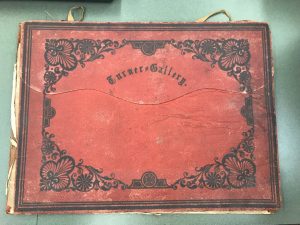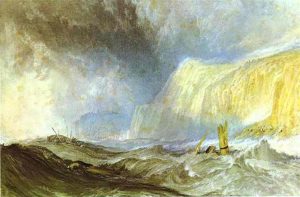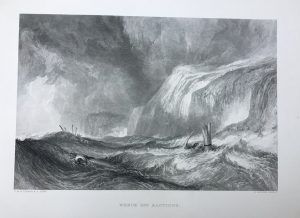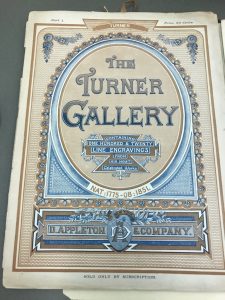Happy New Year! This marks the beginning of my last semester as a graduate assistant at the University of Tulsa. I am excited for the next chapters of my life, but I know that I will enjoy writing new blog posts until then!
Amidst some of the turmoil going on in our world, today I decided to focus on one item in our collection that is far removed from the fray. The Josephine Walker collection of J.M.W. Turner line engravings consists of one very big, very heavy box containing line engravings and their accompanying descriptions. This collection was once bundled together in one big red leather-bound book, but its contents have since been neatly arranged in archival folders for safekeeping.
Joseph Mallord William Turner (J. M. W. Turner) was an English artist who lived from 1775 to 1851. He was recognized for his talent from a young age and was known for big, colorful, sweeping landscapes that were often tumultuous in nature. Unfortunately, engravings are in black and white, so we do not get the complete effect that an original piece of his work would have. “Wreck Off Hastings” (1825) is a perfect example of his tumultuous depiction of nature. The sweeping, violent sea and the large cliffs make up the majority of the painting, with the shipwreck seeming so small and insignificant in comparison. Here is an example of the engraving from our collection next to a full color image of the original work so that you can compare.
Each component of the total 120 engravings would have been purchased separately, with each part consisting of a few engravings and detailed descriptions of the work. The front page of each installment was priced at fifty cents when these engravings were published back in 1880, which would be almost $13 today. The whole collection has forty components, which would have been a total of $20 at the time, or the equivalent of $540 today.
At the time, engraving was a fantastic way to mass-produce images or in this case create copies of artworks for publication. The MET has a really amazing post on their website that you can see if you are interested in how engravings like these were made. We have several engravings that can be found throughout our collections.
If you would like to see more of our treasures, feel free to contact us at speccoll@utulsa.edu. We remain closed to the public and only available in-person to TU students, faculty, and staff, but we are happy to help anybody access our collection digitally.




